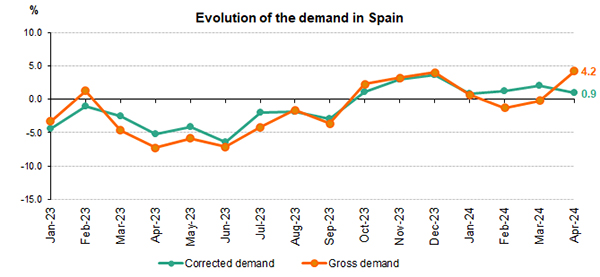For 40 years, we've been driving our country's economic and social progress. Four decades shaping Spain.
Electricity demand in Spain increases by 0.9% in April
- In April, renewables reached a share of 64.6% of total monthly generation and, for the first time, three renewable technologies lead the mix: wind (22.2%), hydro (19.7%) and solar photovoltaic (18.8%).
- Electricity demand has grown by 6.3% in the Balearic Islands and 4.7% in the Canary Islands, having taken the effects of working hours and temperatures into consideration.

National electricity demand increased by 0.9% in April compared to the same month of the previous year, after excluding the effects of temperature and working hours. In gross terms, demand is estimated at 18,938 GWh, 4.2% higher than in April 2023.

In the first four months of 2024, Spain recorded a demand of 81,661 GWh, 0.7% more than in the same period of 2023.
This month, renewables generated 13,515 GWh, 21% more than in April 2023, reaching a share of 64.6% of the total, making this the first month in history in which three renewable technologies lead the Spanish mix: wind (22.2% of the total), hydro (19.7%) and solar photovoltaic (18.8%).
Thus, according to provisional data available today, wind is the leading technology for the seventh month in a row with 4,643 GWh generated, followed by hydro (4,112 GWh), which is almost triple the production in the same month of the previous year. The third source in April was solar photovoltaic energy, which increased its production by 4.4% over the same month in 2023, producing 3,940 GWh.
It is worth noting that on 24 April, solar PV beat its daily production record with 178 GWh; while on 28 April, this technology achieved its highest share in the domestic generation structure, with 24%.
With this boost from renewables, 83.1% of the electricity produced in Spain in April 2024 was free of CO2 equivalent emissions, the highest monthly share since records began.
Demand in the Peninsula increased by 0.6%
In the mainland electricity system, and after considering the effects of working hours and temperature, demand was 0.6% higher than in April 2023. In gross terms, demand this month was 17,754 GWh, 4% higher than in the same month last year.
In the first four months of the year, demand in the mainland was 76,946 GWh, 0.6% higher than that recorded in 2023.
Mainland renewables as a whole generated 67.2% of the total in April, according to provisional data available today, which show production of 13,325 GWh, 21.3% more than in the same month last year. Emission-free technologies accounted for 86.7% of the total.
The mainland generation structure in April was also led by wind power, which was responsible for 22.9% of the total, producing 4,546 GWh during the month.
The electricity system in the Balearic and Canary Islands
In the Balearic Islands, electricity demand in April was 6.3% higher than in the same month in 2023, after considering the effects of working hours and temperatures. Gross demand is estimated at 436,242 MWh, 7.5% more than in April last year. In the first four months of 2024, gross demand in the Balearic Islands is estimated at 1,716,772 MWh, 0.8% more than in the same period of 2023.
In terms of generation, combined cycle, which accounted for 65.5% of the energy produced in the Balearic Islands, was the leading source this month. Renewable energy generation without CO2 equivalent emissions in the Balearic Islands accounted for 17.9% of the total, the highest share ever recorded in the archipelago. Renewable production in the Balearic Islands grew by 17.6% in April compared to the same month last year, reaching 58,481 MWh.
In addition, the underwater link between the peninsula and Majorca helped meet 25.1% of the Balearic Islands' electricity demand during the month.
Meanwhile, in the Canary Islands, electricity demand grew by 4.7% compared to the same month in 2023, considering the effects of working hours and temperatures. Gross demand was 716,020 MWh, representing a 5.9% increase. In the first four months of 2024, demand in the Canary Islands was estimated at 2,872,468 MWh, 4.2% more than in the same period of 2023.
In terms of electricity generation in the Canary Islands, combined cycle, with 46.2% of the total, was also the leading source in April. Renewable and emission-free technologies reached a share of 18.3% of production, with wind power accounting for 13.5%.
Please see our Daily balance report for further information on National, Peninsular, Balearic Islands and Canary Islands electricity systems up to the end of April.
Downloads












